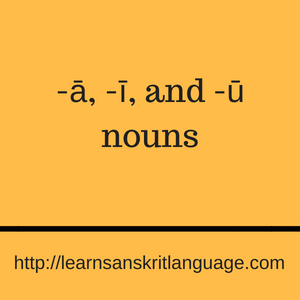Now we shall look at how i and u make endings in various genders. However, first we shall look at how these two affect the endings in masculine gender through the table given below.the example we shall take is of the word “Agni” and we look at the endings with –i.
-ū stems
| चमू | Singular | Dual | Plural |
|---|---|---|---|
| Case 1 (subject) | चमूः camūḥ | चंवौ caṃvau | चंवः caṃvaḥ |
| Case 2 (object) | चमूम् camūm | चंवौ caṃvau | चमूः camūḥ |
| Case 3 ("with") | चंवा caṃvā | चमूभ्याम् camūbhyām | चमूभिः camūbhiḥ |
| Case 4 ("for") | चंवै caṃvai | चमूभ्याम् camūbhyām | चमूभ्यः camūbhyaḥ |
| Case 5 ("from") | चंवाः caṃvāḥ | चमूभ्याम् camūbhyām | चमूभ्यः camūbhyaḥ |
| Case 6 ("of") | चंवाः caṃvāḥ | चंवोः caṃvoḥ | चमूनाम् camūnām |
| Case 7 ("in") | चंवाम् caṃvām | चंवोः caṃvoḥ | चमूषु camūṣu |
| Case 8 (address) | चमु camu | चंवौ caṃvau | चंवः caṃvaḥ |
It can be clearly noticed that there is a regularity as far as the dual endings are concerned and plural are concerned, however an exception is the case two plural ending which just has an “h” at the end, which is unlike the plural endings of other cases.
However, what can also be noticed is the irregularity in the Singular cases. It is in the following ways that singular endings can be understood:
e, case 4 singular becomes ai.
aḥ , 5 and 6 singular becomes āḥ
i in case 7 singular becomes ām
As for case 1 singular, a visaarga is used.
In case 8, a short vowel, is used, there is an ṃv not mv.
-ī stems
Now we shall look at –ī stems, its behaviour pattern is the same as the –u stems. Please look at the table below to learn further about the same. The example we take is of vapi.
| वापी | Singular | Dual | Plural |
|---|---|---|---|
| Case 1 (subject) | वापी vāpī | वाप्यौ vāpyau | वाप्यः vāpyaḥ |
| Case 2 (object) | वापीम् vāpīm | वाप्यौ vāpyau | वापीः vāpīḥ |
| Case 3 ("with") | वाप्या vāpyā | वापीभ्याम् vāpībhyām | वापीभिः vāpībhiḥ |
| Case 4 ("for") | वाप्यै vāpyai | वापीभ्याम् vāpībhyām | वापीभ्यः vāpībhyaḥ |
| Case 5 ("from") | वाप्याः vāpyāḥ | वापीभ्याम् vāpībhyām | वापीभ्यः vāpībhyaḥ |
| Case 6 ("of") | वाप्याः vāpyāḥ | वाप्योः vāpyoḥ | वापीनाम् vāpīnām |
| Case 7 ("in") | वाप्याम् vāpyām | वाप्योः vāpyoḥ | वपीषु vāpīṣu |
| Case 8 (address) | वापि vāpi | वाप्यौ vāpyau | वाप्यः vāpyaḥ |
-ā stems
It is quite noticeable that the endings are the same as those above, however, what is also noticeable is that in the case one singular, the visarga is not used. Now we shall look at –a stems, they are what can be called regular, however, their features are odd.
| विद्या | Singular | Dual | Plural |
|---|---|---|---|
| Case 1 (subject) | विद्या vidyā | विद्ये vidye | विद्याः vidyāḥ |
| Case 2 (object) | विद्याम् vidyām | विद्ये vidye | विद्याः vidyāḥ |
| Case 3 ("with") | विद्यया vidyayā | विद्याभ्याम् vidyābhyām | विद्याभिः vidyābhiḥ |
| Case 4 ("for") | विद्यायै vidyāyai | विद्याभ्याम् vidyābhyām | विद्याभ्यः vidyābhyaḥ |
| Case 5 ("from") | विद्यायाः vidyāyāḥ | विद्याभ्याम् vidyābhyām | विद्याभ्यः vidyābhyaḥ |
| Case 6 ("of") | विद्यायाः vidyāyāḥ | विद्ययोः vidyayoḥ | विद्यानाम् vidyānām |
| Case 7 ("in") | विद्यायाम् vidyāyām | विद्ययोः vidyayoḥ | विद्यासु vidyāsu |
| Case 8 (address) | विद्ये vidye | विद्ये vidye | विद्याः vidyāḥ |
Plural endings are similar to the nouns in the tables above this one; however, that is not the same with dual or singular endings.
Use of vidyay in the case 3 singular as well as case 6 and 7 in the dual form
Use of vidyāy in the cases 4 to 7 in the singular form.
Use of e endings in the entire singular and dual forms.
The feminine tad
Now we shall focus on one more factor that leads to the formation of feminine nouns, this is tad. Please look at the table given below to learn further.
| तद् | Singular | Dual | Plural |
|---|---|---|---|
| Case 1 (subject) | सा sā | ते te | ताः tāḥ |
| Case 2 (object) | ताम् tām | ते te | ताः tāḥ |
| Case 3 ("with") | तया tayā | ताभ्याम् tābhyām | ताभिः tābhiḥ |
| Case 4 ("for") | तस्यै tasyai | ताभ्याम् tābhyām | ताभ्यः tābhyaḥ |
| Case 5 ("from") | तस्याः tasyāḥ | ताभ्याम् tābhyām | ताभ्यः tābhyaḥ |
| Case 6 ("of") | तस्याः tasyāḥ | तयोः tayoḥ | तासाम् tāsām |
| Case 7 ("in") | तस्याम् tasyām | तयोः tayoḥ | तासु tāsu |
The patterns noticed are similar to that of –a stems.
In singular form case 3, in dual form, case 6 and 7, tay is used.
In singular form, case 4 to 7, tasy is used.
As noticed in the a-stems as well, e-ending appears in the dual form here as well. However, a significant distinction is that in case 6, what appears is tāsām, instead of tānām.



